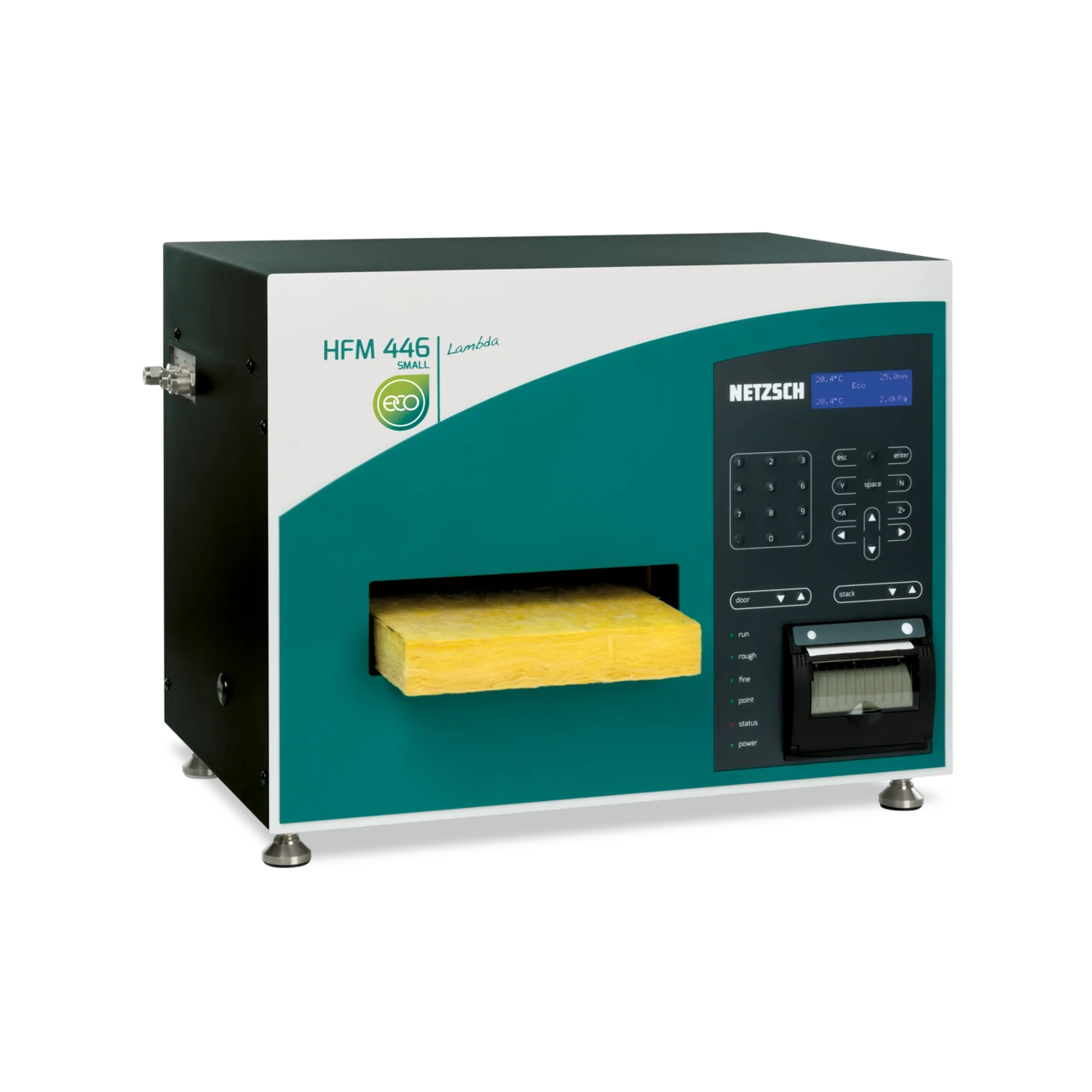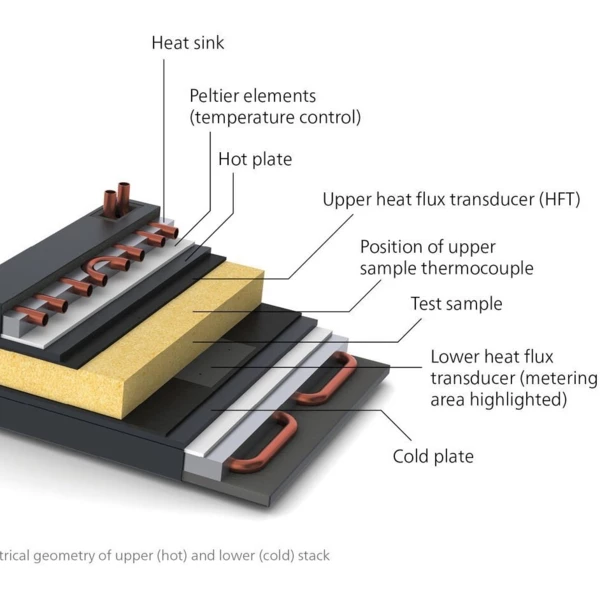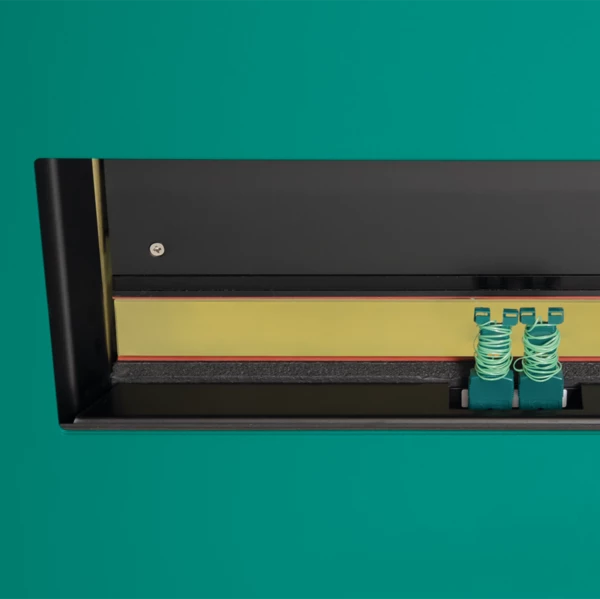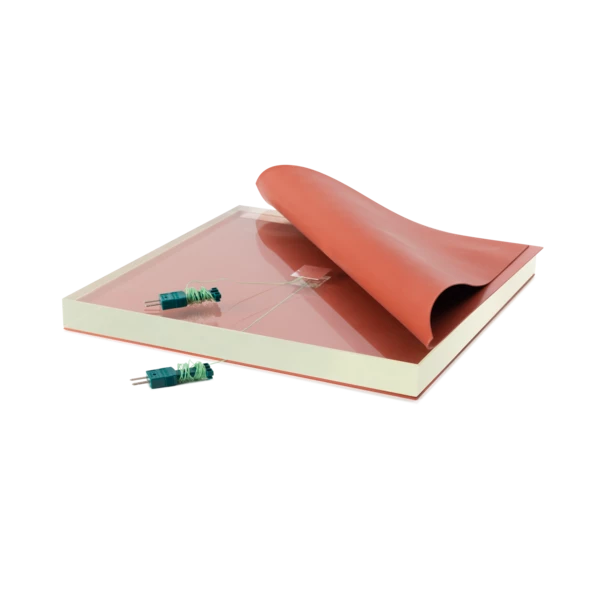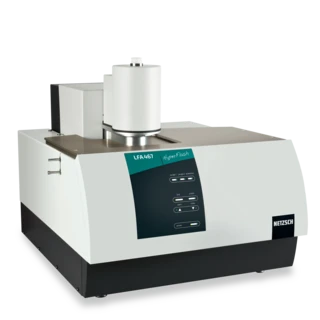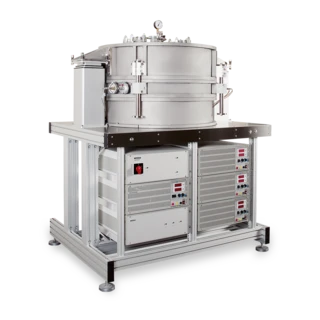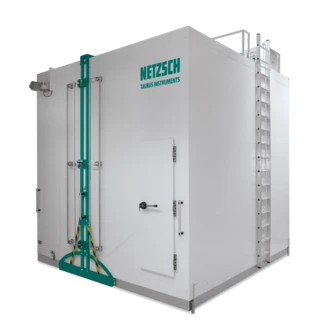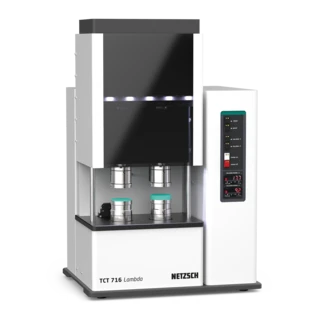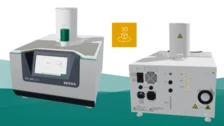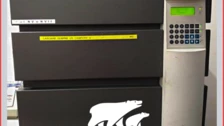Highlights
Dedicated to all-sized specimens equipped with great features.
Our Heat Flow Meter HFM 446 Lambda Small combines innovative features:
Our SmartMode streamlines measurement, evaluation, and reporting processes, empowering operators with intuitive tools such as AutoCalibration, wizards, user-defined methods, and detailed reports. Equipped with dual heat flux transducers, our instrument ensures precision and sensitivity in monitoring heat flow to and from specimens. Calibration with reference materials of known thermal conductivity enhances accuracy, while various calibration options further boost precision.
In addition to measuring thermal conductivity, our hardware and software enable the determination of specific heat capacity (cp), providing a comprehensive analysis of thermal properties. Furthermore, the instrument prioritizes resource conservation with Eco-Mode, allowing for energy-saving standby and quick measurement startup in Idle-Mode. Users can easily customize activation timings using the scheduler, promoting efficiency in operations.

Saving and Efficient use of Energy
Today, global attention towards saving and efficiently using energy has never been higher. Industries and academia worldwide are actively researching ways to conserve energy and utilize alternative resources. Among the key focuses are insulation materials and thermal efficiency in buildings, holding vast potential. Ensuring high-quality manufacturing and strict performance control of these materials is paramount.
Various standards and guidelines govern these products to guarantee their efficacy, given the massive production volumes globally. Our latest offering, the HFM 446 Lambda Eco-Line, ensures peak energy efficiency in measuring Thermal Conductivity.
Method
Thermal Conductivity - A Key Parameter for Improved Energy Efficiency
Thermal conductivity is a measure of a material's ability to conduct heat. It quantifies how well heat can move through a substance. The most common method for measuring thermal conductivity is the steady-state method, also known as the heat flow meter method.
In this method, a sample of the material with known dimensions is placed between two plates of different temperatures. One plate is heated, while the other is cooled, creating a temperature gradient across the material. Heat flows through the sample from the hot plate to the cold plate. The rate of heat transfer (heat flux) and the temperature difference across the sample are measured.
Using Fourier's law of heat conduction, which relates the heat flux, temperature gradient, and thermal conductivity of the material, the thermal conductivity of the sample can be calculated. This calculation accounts for factors such as the dimensions of the sample and the thermal resistance at the interface between the sample and the plates.
By repeating the measurements with different samples and under various conditions, the thermal conductivity of the material can be accurately determined. This information is crucial for evaluating the insulation properties of materials used in building construction, electronics, and various other applications where heat transfer is a concern.
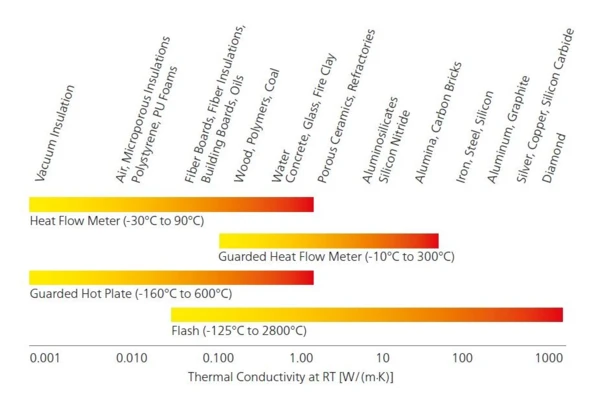

The HFM is an exact, fast and easy-to-use instrument for measuring the low thermal conductivity λ of insulation materials.
In a heat flow meter (HFM), the test specimen is placed between two heated plates controlled to a user-defined mean sample temperature and temperature gradient to measure heat flowing through the specimen. The sample thickness L is measured by an internal thickness gauge. Alternatively, the user can enter and drive to the desired thickness, which is of particular interest for compressible samples. The heat flow Q through the sample is measured by two calibrated heat flux transducers covering a large area of both sides of the specimen.
After reaching thermal equilibrium, the test is done. The heat flux transducer output is calibrated using a reference standard. For the calculation of the thermal conductivity λ and the thermal resistance R, the average heat flux Q/A, the sample thickness L, and the temperature gradient ΔT are used, in accordance with Fourier’s Law (see formulas on the right). The thermal transmittance, also known as U-value, is the reciprocal of the total thermal resistance. The lower the U-value, the better the insulating ability.
NETZSCH offers more exciting products that support you in measuring Thermal Conductivity:
Specifications
| HFM 446 Lambda Small | |
|---|---|
| Standards | ASTM C518, ISO 8301, JIS A1412, DIN EN 12667, DIN EN 12664 |
| Type | Stand-alone, with integrated printer |
| Thermal conductivity range | 0.007 to 2 W/(m·K)**
Small and Medium: 2.0 W/(m·K) achievable with optional instrumentation kit, recommended for hard materials and those with higher thermal conductivity Performance data:
→ All performance data is verified with NIST SRM 1450 D (thickness 25 mm) |
| Plate temperature range | -20°C to 90°C |
| Air-tight system | Sample compartment with possibility to introduce purge gas |
| Metering area heat flux transducer | 102 mm x 102 mm |
| Chiller system | External; constant temperature setpoint over plate temperature range |
| Plate temperature control | Peltier system |
| Plate motion | Motorized |
| Plate thermocouples | Three thermocouples on each plate, type K (two extra thermocouples with instrumentation kit) |
| Thermocouple resolution | ± 0.01°C |
| Number of setpoints | Up to 99 |
| Specimen sizes (max.) | 203 mm x 203 mm x 51 mm |
| Variable load/ contact force | 0 to 854 N (21 kPa on 203 x 203 mm²) Force-controlled adjustment of the contact force or the desired thickness, and thus density, of compressible materials |
| Thickness determination |
|
| Software features |
|
** Please note: In the very low thermal conductivity range, accuracy of Lambda (λ) values can be restricted
Accessories and more:
Brochures and Data Sheets
Software
All software highlights at a glance
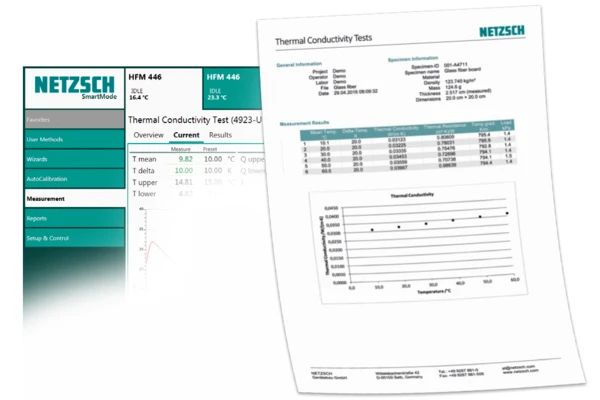
Highest Usability
SmartMode is the user-friendly, smoothly running user interface of the HFM Proteus® software. It is characterized by a logical structure which quickly gives a clear overview of the current measurement status and provides various report and export possibilities. After completing the test, all relevant results can be directly printed out by the integrated printer or a report can be created by the software when a PC is connected.
Calibration in Next to no Time
For calibration purposes, the thermal conductivity values of the most common certified reference materials, such as NIST SRM 1450d, are already stored in the software. However, AutoCalibration also offers the ability to create calibration curves for any user-defined material on the basis of up to 99 freely selectable temperatures.
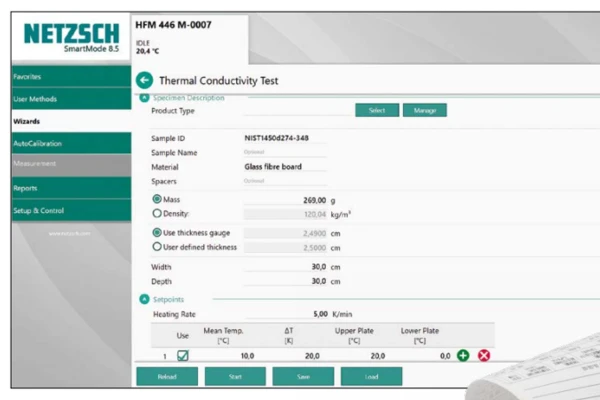
Find out even more:
Related Devices
- HFM 446 Lambda Small Eco-Line
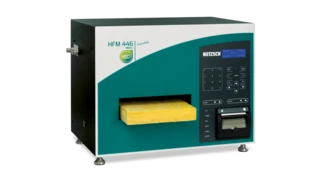
An exact, fast and easy-to-use instrument for measuring the low thermal conductivity λ of insulation materials.
- Thermal conductivity range: 0.007 to 2 W/(m·K)
- Metering area heat flux transducer: 102 mm x 102 mm
- Specimen sizes (max.): 203 mm x 203 mm x 51 mm
- HFM 446 Lambda Medium Eco-Line
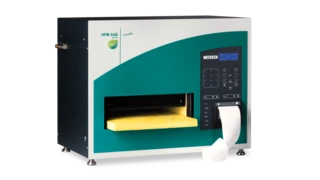
An exact, fast and easy-to-use instrument for measuring the low thermal conductivity λ of insulation materials.
- Thermal conductivity range: 0.002 to 2 W/(m·K)
- Metering area heat flux transducer: 102 mm x 102 mm
- Specimen sizes (max.): 305 mm x 305 mm x 105 mm
- HFM 446 Lambda Large Eco-Line

An exact, fast and easy-to-use instrument for measuring the low thermal conductivity λ of insulation materials.
- Thermal conductivity range: 0.001 to 0.5 W/(m·K)
- Metering area heat flux transducer: 0.001 to 0.5 W/(m·K)
- Specimen sizes (max.): 611 mm x 611 mm x 200 mm

Consultancy & Sales
Do you have further questions about the instrument or the method and would like to speak to a sales representative?
Service & Support
Do you already have an instrument and need technical support or spare parts?
